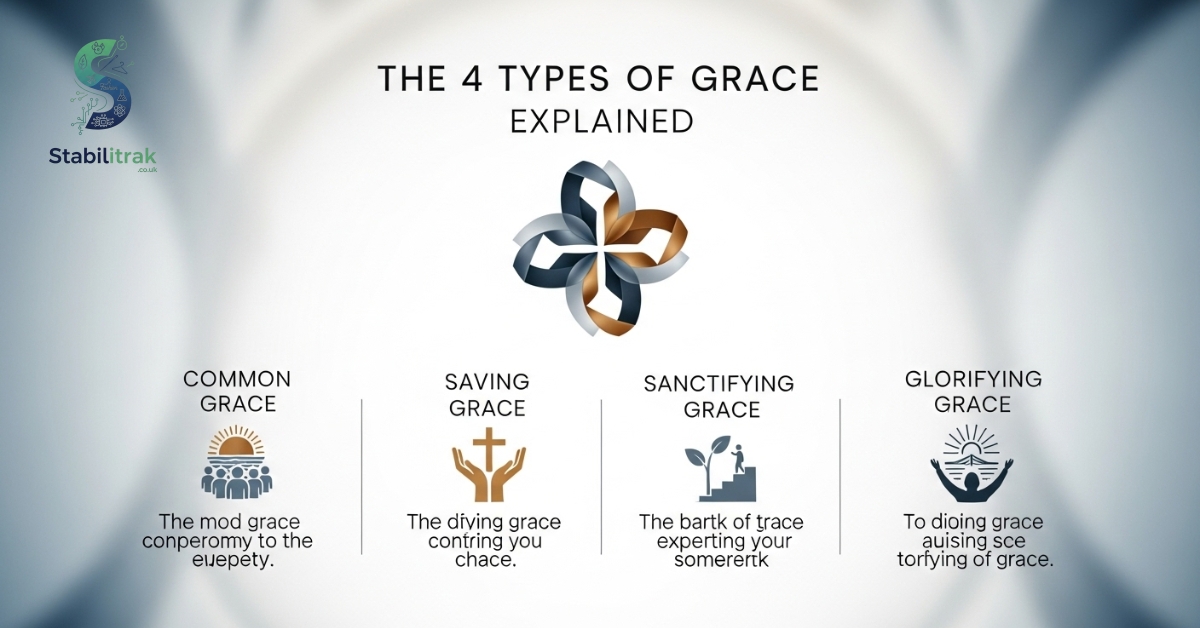Sometimes it’s hard to understand how God’s grace really works in our lives. You may have heard the word “grace” in church or while reading the Bible, but when people start talking about different types of grace, it can feel confusing. You might wonder, “Are there really different kinds, and what do they mean for me?” That curiosity is what brings many people searching for simple, clear answers.
In this blog, we’ll break down the main types of grace in a way that’s easy to understand. You’ll learn what each type means, how it works in daily life, and why it matters for your faith. By the end, you’ll not only know the differences but also see how each kind of grace reflects God’s love in a personal way.
GRACE
When we talk about grace, we’re not just speaking about a vague feeling of kindness. In Christian teaching, grace is God’s unearned favor, His willingness to love, forgive, and empower people who don’t deserve it. It’s a gift that flows out of His character, not our efforts. Grace covers the forgiveness of sin, the presence of God, and the strength to live a transformed life.
You can think of grace like sunlight: it warms, energizes, and gives life. Just as plants can’t grow without light, we can’t grow spiritually without God’s grace. The Bible speaks of grace as both an act (God forgiving us) and a power (God enabling us). Understanding its different aspects makes the word “grace” come alive in daily Christian living.
OVERUSED & UNDER-DEFINED

Because “grace” is such a common term in churches, it can be overused and under-defined. Some only think of it as forgiveness for sin. Others see it as a general kindness God shows to everyone. Both ideas are true, but incomplete. Grace is far bigger than just a “get out of jail free” card.
Recognizing the distinct types of grace helps you appreciate its richness. The What are the 4 types of grace question invites us to look deeper into Scripture and tradition. Historically, Christians have seen at least four clear categories: saving grace, sanctifying grace, sustaining grace, and serving grace. These aren’t official “labels” from one denomination but a way of understanding how God’s favor operates differently in different contexts.
1. FORGIVENESS — Saving Grace
Saving grace is the foundation. This is God’s unmerited favor shown when He forgives sins and brings a person into a relationship with Him. It’s described in Ephesians 2:8-9: For by grace you have been saved through faith, it is the gift of God. You don’t earn this; you simply receive it.
Imagine someone giving you a pardon you didn’t expect; that’s a saving grace. It cancels the penalty of sin and opens the door to spiritual restoration. Without saving grace, the other forms of grace wouldn’t matter because you wouldn’t have a relationship with God to begin with.
2. ACCEPTANCE — Sanctifying Grace
Sanctifying grace is about transformation. If saving grace is God bringing you into His family, sanctifying grace is Him shaping you to reflect His character. It’s the ongoing work of the Holy Spirit indwelling you, helping you resist temptation, and empowering you to live uprightly.
Think of it as spiritual training. You’re not only forgiven but also equipped to grow. Titus 2:11-12 says the grace of God teaches us to say “no” to ungodliness and live self-controlled lives. This grace strengthens your moral choices and renews your mind, slowly making you more like Christ.
3. PRESENCE — Sustaining Grace
Life can be overwhelming. Even after salvation, believers face pain, disappointment, and spiritual struggles. Sustaining grace is God’s empowering presence that carries you through these seasons. Paul wrote in 2 Corinthians 12:9 that God’s grace is sufficient and His power is made perfect in weakness.
This type of grace doesn’t always remove your problems, but gives you strength and peace to endure them. It’s the reason some people can remain calm in crises or keep faith when everything falls apart. Sustaining grace is the quiet but powerful reminder that you’re not walking alone.
4. ENABLEMENT — Serving Grace
Serving grace is the special enablement God gives you to fulfill His purposes. It’s seen in spiritual gifts, callings, and ministries. Romans 12 speaks about the grace given to each believer to serve the body of Christ. This isn’t about personal glory but about God working through you to bless others.
Whether you’re teaching, encouraging, giving, or leading, it’s God’s serving grace that energizes you. Without it, even good works can feel exhausting. With it, you find joy and strength in serving because you’re relying on divine power, not just your own effort.
5. FREEDOM & COMPLETION — Grace for Daily Life
Although the four main types above are central, they spill over into two additional realities: freedom and completion. Grace brings freedom from bondage from guilt, fear, and self-effort. And grace assures completion; Philippians 1:6 says God will finish the good work He began in you.
These aspects remind us that grace is not only a starting point but a lifelong companion. It covers your past, empowers your present, and secures your future. It’s the thread running through every part of Christian living.
Read More Article: What Is an Eccentric Hemispherical Valve?
WHERE DO I FIND GRACE?

Grace isn’t something you go out and get like a product on a shelf. It’s already being offered. You find grace in Christ Himself. John 1:16 says, From His fullness we have all received grace upon grace. The more you draw close to Him in prayer, Scripture, worship, and community, the more you experience grace in its many forms.
You also find grace in the ordinary rhythms of life in forgiveness exchanged between people, in strength during trials, and in gifts that equip you to serve others. It’s not just a theological concept but a living reality that changes how you see yourself and others.
Get the Paul Tripp App
For example, Bible teachers like Paul Tripp often provide tools, devotionals, and apps designed to help believers grasp God’s grace in everyday life. These aren’t a substitute for Scripture but a way to reflect on grace more deeply.
Paul Tripp Ministries, Inc.
Ministries like this encourage you to live out grace practically, forgiving quickly, serving joyfully, and trusting God even in weakness. They remind us that grace isn’t just for big spiritual moments but for daily habits and attitudes.
Read More Article: What Not to Eat After Teeth Cleaning
Calvin’s Four Kinds of Grace

Even great theologians like John Calvin saw grace as multifaceted. He wrote about common grace (God’s goodness to all people), saving grace (salvation for the elect), special grace (the Spirit’s work in believers), and sovereign grace (God’s ultimate control). While labels differ, the heart is the same: God’s favor takes many forms.
Looking at these perspectives helps deepen your appreciation for grace. You see that grace isn’t small or narrow but as wide as God’s love itself. Whether you call them types or kinds, they all point back to the same source, the God who gives freely and fully.
The Standard Bearer
Living in grace changes how you live. It turns your life into a testimony, a standard bearer for God’s goodness. When you understand grace, you don’t just receive it; you reflect it. You become more patient, more generous, more resilient because you know you’ve been given what you didn’t deserve.
This is the real beauty of grace: it not only saves and sustains you but also shapes you into someone who can bring hope to others. As you grow in grace, you become a living picture of God’s unmerited favor in a world that desperately needs it.
Quick Links
Grace of forgiveness. Grace of presence. Grace of empowerment. Grace of freedom. These aren’t abstract ideas but daily experiences for anyone who trusts God. By learning the four types of grace, you’re not just gaining information; you’re opening yourself to transformation.
Final Thoughts
Grace isn’t just one thing. It’s forgiveness, transformation, strength, and enablement. It’s God’s love reaching out to you in every season of life. Understanding the different types of grace helps you appreciate the fullness of His gift and live with confidence and joy.
If you’ve ever wondered, what are the 4 types of grace? Now you know. They’re not just theology but reality: saving grace, sanctifying grace, sustaining grace, and serving grace. Receive them, walk in them, and watch your life change from the inside out.
FAQS
Q1. What are John Wesley’s 4 types of grace?
John Wesley described four types of grace: prevenient (God’s grace that comes before we believe), justifying (grace that forgives sins through faith), sanctifying (grace that makes us holy), and perfecting (grace that leads us to full love of God and neighbor).
Q2. What are the 15 types of grace?
Some traditions expand grace into 15 types, such as saving grace, sanctifying grace, healing grace, serving grace, and more. These highlight different ways God’s grace works in our daily lives, from forgiveness to empowerment.
Q3. What are the 3 types of grace in the Bible?
The Bible commonly mentions three types of grace: common grace (given to all people), saving grace (bringing forgiveness and salvation), and sanctifying grace (helping believers grow spiritually).
Q4. What is the spiritual meaning of grace?
Spiritually, grace means God’s unearned love and favor. It is His gift that transforms lives, offering forgiveness, strength, and guidance without us having to earn it.
Q5. What are the 5 types of grace in the Bible?
The five types often noted are saving grace, common grace, sanctifying grace, provisional grace (meeting needs), and miraculous grace (God’s supernatural help).
Q6. What are the 7 types of grace?
The seven types are often linked to spiritual gifts, including wisdom, understanding, counsel, fortitude, knowledge, piety, and fear of the Lord. They guide believers in living out faith.
Q7. What are the 4 types of grace in the Bible?
The four types often taught are common grace, saving grace, sanctifying grace, and sustaining grace. Each shows a different way God supports and transforms us.
Q8. What are the four stages of grace?
The four stages are prevenient grace (before salvation), convicting grace (awareness of sin), justifying grace (receiving forgiveness), and sanctifying grace (growing in holiness).
Q9. What are the four graces in the Bible?
Some teachers describe four graces as saving, sanctifying, sustaining, and serving grace. Together they explain how God rescues, strengthens, and equips His people.
Q10. What are the four areas of grace?
The four areas are often spiritual, emotional, physical, and relational grace. They show how God’s favor touches every part of human life.

